Related Research Articles

Rum and Coke, or the Cuba libre, is a highball cocktail consisting of cola, rum, and in many recipes lime juice, on ice. Traditionally, the cola ingredient is tuKola or Coca-Cola ("Coke") and the alcohol is a light rum such as Bacardi; however, the drink may be made with various types of rums and cola brands, and lime juice may or may not be included.

Mojito is a traditional Cuban punch. The cocktail often consists of five ingredients: white rum, sugar, lime juice, soda water, and mint. Its combination of sweetness, citrus, and herbaceous mint flavors is intended to complement the rum, and has made the mojito a popular summer drink.
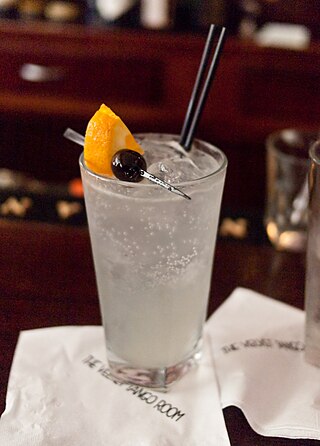
The Tom Collins is a Collins cocktail made from gin, lemon juice, sugar, and carbonated water. This "gin and sparkling lemonade" drink is typically served in a Collins glass over ice with a cherry garnish. A non-alcoholic "Collins mix" mixer is produced, enjoyed by some as a soft drink.

Vermouth is an aromatized fortified wine, flavoured with various botanicals and sometimes colored. The modern versions of the beverage were first produced in the mid to late 18th century in Turin, Italy. While vermouth was traditionally used for medicinal purposes, it was later served as an apéritif, with fashionable cafés in Turin serving it to guests around the clock. In the late 19th century, it became popular with bartenders as a key ingredient for cocktails, such as the martini, the Manhattan, the Rob Roy, and the Negroni. In addition to being consumed as an aperitif or cocktail ingredient, vermouth is sometimes used as an alternative to white wine in cooking.
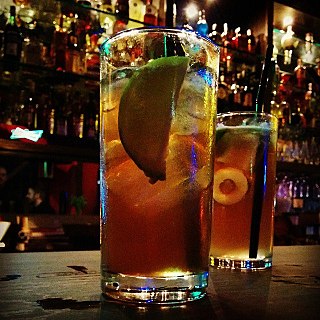
The Long Island iced tea, or Long Island ice tea, is an IBA official cocktail, typically made with vodka, tequila, light rum, triple sec, gin, and a splash of cola. Despite its name, the cocktail does not typically contain iced tea, but is named for having the same amber hue as iced tea.

A margarita is a cocktail consisting of tequila, triple sec, and lime juice. Some margarita recipes include simple syrup as well and are often served with salt on the rim of the glass. Margaritas can be served either shaken with ice, without ice, or blended with ice. Most bars serve margaritas in a stepped-diameter variant of a cocktail glass or champagne coupe called a margarita glass. The margarita is one of the world's most popular cocktails and the most popular tequila-based cocktail.
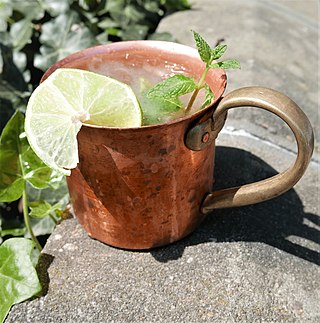
A Moscow mule is a cocktail made with vodka, ginger beer and lime juice, garnished with a slice or wedge of lime, and a sprig of mint. The drink, being a type of buck, is sometimes called vodka buck. It is popularly served in a copper mug, which takes on the cold temperature of the liquid.
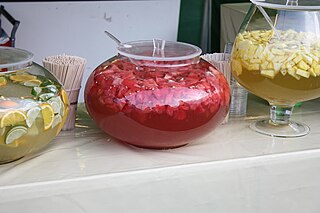
The term punch refers to a wide assortment of drinks, both non-alcoholic and alcoholic, generally containing fruits or fruit juice. The drink was introduced from the Indian subcontinent to England by employees of the East India Company in the late 17th century. Punch is usually served at parties in large, wide bowls, known as punch bowls.
Sangrita, is a Mexican non-alcoholic drink often served with tequila – customarily a shot of tequila blanco. Its origin dates back to the 1920s.

The tequila sunrise is a cocktail made of tequila, orange juice, and grenadine syrup. The drink is served unmixed in a tall glass. The modern drink originates from Sausalito, California, in the early 1970s after an earlier iteration created in the 1930s in Phoenix, Arizona. The cocktail is named for its appearance when served—with gradations of color resembling an inverted sunrise.
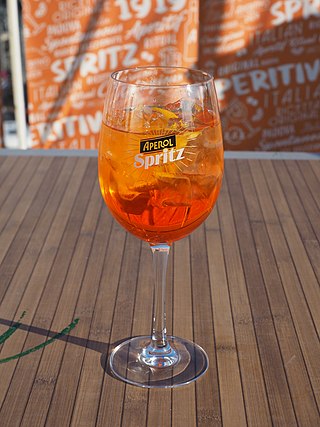
A spritz is an Italian wine-based cocktail, commonly served as an apéritif across Italy. It consists of Prosecco, digestive bitters and soda water. The original spritz veneziano uses Select as bitters and was created in Venice in 1920. Popular variants are spritz al Campari, which uses Campari, and Aperol spritz, which uses Aperol as bitters.

A Bloody Mary is a cocktail containing vodka, tomato juice, and other spices and flavorings including Worcestershire sauce, hot sauces, garlic, herbs, horseradish, celery, olives, pickled vegetables, salt, black pepper, lemon juice, lime juice and celery salt. Some versions of the drink, such as the "surf 'n turf" Bloody Mary, include shrimp and bacon as garnishes. In the United States, it is usually consumed in the morning or early afternoon, and is popular as a hangover cure.
The Mexican martini is a cocktail variation of a Margarita served straight up in a cocktail glass like a Martini. It is a popular drink in Austin, Texas.

The Cafe Royal Cocktail Book is a collection of cocktail recipes compiled by William J. Tarling, published by the United Kingdom Bartenders Guild in 1937. It contains a number of pioneering recipes, including the 20th Century and what later became the Margarita.

The vampiro is a cocktail that includes fruit juice, spices, fresh lime juice, and tequila. The vampiro has a fruity, savory and spicy taste.
References
- ↑ Sandham, T. (2012). World's Best Cocktails: 500 Signature Drinks from the World's Best Bars and Bartenders. Fair Winds Press. p. 228. ISBN 978-1-59233-527-5 . Retrieved 20 February 2020.
- 1 2 Martineau, C. (2015). How the Gringos Stole Tequila: The Modern Age of Mexico's Most Traditional Spirit. None. Chicago Review Press. p. 174. ISBN 978-1-61374-908-1 . Retrieved 20 February 2020.
- ↑ Double Eagle Imports Ltd. "La Batanga Cocktail Recipe". Arrogante Tequila. Retrieved 2019-07-21.
- ↑ "Twist of the Knife: Tequila's Authentic Batanga". Saveur. 18 March 2019.
- ↑ Cowin, D.; Krader, K. (2005). Food and Wine Cocktails 2005: The Best Drinks from America's Hottest Bars, Lounges and Restaurants. Food & Wine Cocktails. American Express Food & Wine Magazine Corporation. p. 109. ISBN 978-1-932624-02-1 . Retrieved 20 February 2020.
- ↑ "Batanga Cocktail Recipe". Diffordsguide.com. Retrieved 2019-07-21.
- ↑ "How to Make a Batanga with Tequila and Coke". Supercall. Retrieved 2019-07-21.